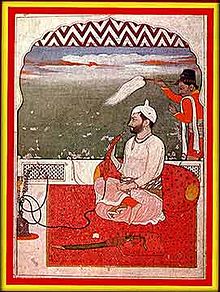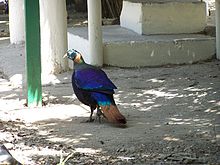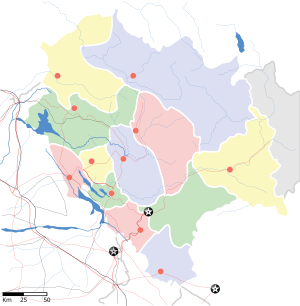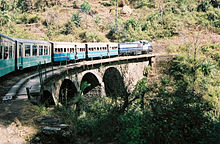HIMACHAL HEAVEN
between 2250 and 1750 BCE.[14] Tribes such as the Koili, Hali, Dagi, Dhaugri, Dasa, Khasa, Kinnar, and Kirat inhabited the region from the prehistoric era.[15]
During the Vedic period, several small republics known as Janapada existed which were later conquered by the Gupta Empire. After a brief period of supremacy by King Harshavardhana, the region was divided into several local powers headed by chieftains, including some Rajput principalities. These kingdoms enjoyed a large degree of independence and were invaded by Delhi Sultanate a number of times.[14] Mahmud Ghaznavi conquered Kangra at the beginning of the 10th century. Timur and Sikander Lodi also marched through the lower hills of the state and captured a number of forts and fought many battles.[14] Several hill states acknowledged Mughal suzerainty and paid regular tribute to the Mughals.[16]
The Kingdom of Gorkha conquered many kingdoms and came to power in Nepal in 1768.[14] They consolidated their military power and began to expand their territory.[14]Gradually, the Kingdom of Nepal annexed Sirmour and Shimla. Under the leadership ofAmar Singh Thapa, the Nepali army laid siege to Kangra. They managed to defeat Sansar Chand Katoch, the ruler of Kangra, in 1806 with the help of many provincial chiefs. However, the Nepali army could not capture Kangra fort which came under Maharaja Ranjeet Singh in 1809. After the defeat, they began to expand towards the south of the state. However, Raja Ram Singh, Raja of Siba State, captured the fort of Siba from the remnants of Lahore Darbar in Samvat 1846,[14] during the First Anglo-Sikh War.
They came into direct conflict with the British along the tarai belt after which the British expelled them from the provinces of the Satluj.[14] The British gradually emerged as the paramount power in the region.[14] In the revolt of 1857, or first Indian war of independence, arising from a number of grievances against the British,[14] the people of the hill states were not as politically active as were those in other parts of the country.[14] They and their rulers, with the exception of Bushahr, remained more or less inactive.[14] Some, including the rulers of Chamba, Bilaspur, Bhagal and Dhami, rendered help to the British government during the revolt.
The British territories came under the British Crown after Queen Victoria's proclamation of 1858. The states of Chamba, Mandi and Bilaspur made good progress in many fields during the British rule.[14] During World War I, virtually all rulers of the hill states remained loyal and contributed to the British war effort, both in the form of men and materials. Among these were the states of Kangra, Jaswan, Datarpur, Guler, Rajgarh, Nurpur, Chamba, Suket, Mandi, and Bilaspur.[14]
After independence, the Chief Commissioner's Province of Himachal Pradesh. was organized on 15 April 1948 as a result of integration of 28 petty princely states (including feudal princes and zaildars) in the promontories of the western Himalaya. These were known as the Simla Hills States and four Punjab southern hill states under the Himachal Pradesh (Administration) Order, 1948 under Sections 3 and 4 of the Extra-Provincial Jurisdiction Act, 1947 (later renamed as the Foreign Jurisdiction Act, 1947 vide A.O. of 1950). The State of Bilaspur was merged into Himachal Pradesh on 1 April 1954 by the Himachal Pradesh and Bilaspur (New State) Act, 1954.
Himachal became a part C state on 26 January 1951 with the implementation of the Constitution of India and the Lieutenant Governor was appointed. The Legislative Assembly was elected in 1952. Himachal Pradesh became a union territory on 1 November 1956.[14] Some areas of Punjab State—namely Simla, Kangra, Kulu and Lahul and Spiti Districts, Nalagarh tehsil of Ambala District, Lohara, Amb and Una kanungo circles, some area of Santokhgarh kanungo circle and some other specified area of Una tehsil of Hoshiarpur District, besides some parts of Dhar Kalan Kanungo circle of Pathankot tehsil of Gurdaspur District—were merged with Himachal Pradesh on 1 November 1966 on enactment by Parliament of Punjab Reorganisation Act, 1966. On 18 December 1970, the State of Himachal Pradesh Act was passed by Parliament, and the new state came into being on 25 January 1971. Himachal became the 18th state of the Indian Union with Dr. Yashwant Singh Parmar as its first chief minister.[14]
Geography and climate[edit]
Himachal is in the western Himalayas. Covering an area of 55,673 square kilometres (21,495 sq mi),[3] it is a mountainous state. Most of the state lies on the foothills of the Dhauladhar Range. At 7,025 m Shilla is the highest mountain peak in the state of Himachal Pradesh.[17]
The drainage system of Himachal is composed both of rivers and glaciers. Himalayan rivers criss-cross the entire mountain chain. Himachal Pradesh provides water to both the Indus and Ganges basins.[18] The drainage systems of the region are the Chandra Bhaga or theChenab, the Ravi, the Beas, the Sutlej, and the Yamuna. These rivers are perennial and are fed by snow and rainfall. They are protected by an extensive cover of natural vegetation.[18]
Due to extreme variation in elevation, great variation occurs in the climatic conditions of Himachal . The climate varies from hot and subhumid tropical in the southern tracts to, with more elevation, cold, alpine, and glacial in the northern and eastern mountain ranges.[19]The state's winter capital, Dharamsala receives very heavy rainfall, while areas like Lahaul and Spiti are cold and almost rainless. Broadly, Himachal experiences three seasons: summer, winter, and rainy season. Summer lasts from mid-April till the end of June and most parts become very hot (except in the alpinezone which experiences a mild summer) with the average temperature ranging from 28 to 32 °C (82 to 90 °F). Winter lasts from late November till mid March. Snowfall is common in alpine tracts (generally above 2,200 metres (7,218 ft) i.e. in the higher and trans-Himalayan region). Media in Himachal
Flora and fauna[edit]
According to 2003 Forest Survey of India report, legally defined forest areas constitute 66.52% of the area of Himachal Pradesh.[20] Vegetation in the state is dictated by elevation and precipitation. The state endows with a high diversity of medicinal and aromatic plants.[21] Lahaul-Spiti region of the state, being a cold desert, supports unique plants of medicinal value including Ferula jaeschkeana, Hyoscyamus niger, Lancea tibetica, andSaussurea bracteata.[22][23]
Himachal is also said to be the fruit bowl of the country,[24] with orchards being widespread. Meadows and pastures are also seen clinging to steep slopes. After the winter season, the hillsides and orchards bloom with wild flowers, while gladiolas, carnations, marigolds,[25] roses,chrysanthemums, tulips and lilies are carefully cultivated. The state government is gearing up to make Himachal Pradesh as the flower basket of the world.[citation needed] Himachal Pradesh Horticultural Produce Marketing and Processing Corporation Ltd. (HPMC) is a state body that markets fresh and processed fruits.[26]
Himachal Pradesh has around 463 bird[27] 77 mammalian, 44 reptile and 80 fish species.[28] Great Himalayan National Park, a UNESCO World Heritage Site and Pin Valley National Park are the national Parks located in the state.[28][29] The state also has 30 wildlife sanctuaries and 3 conservation reserves.[29]
Government[edit]
The Legislative Assembly of Himachal Pradesh has no pre-Constitution history. The State itself is a post-Independence creation. It came into being as a centrally administered territory on 15 April 1948 from the integration of thirty erstwhile princely states.[30]
Himachal Pradesh is governed through a parliamentary system of representative democracy, a feature the state shares with other Indian states. Universal suffrage is granted to residents. The legislature consists of elected members and special office bearers such as the Speaker and the Deputy Speaker who are elected by the members. Assembly meetings are presided over by the Speaker or the Deputy Speaker in the Speaker's absence. The judiciary is composed of the Himachal Pradesh High Courtand a system of lower courts. Executive authority is vested in the Council of Ministers headed by the Chief Minister, although the titular head of government is the Governor. The Governor is thehead of state appointed by the President of India. The leader of the party or coalition with a majority in the Legislative Assembly is appointed as the Chief Minister by the Governor, and the Council of Ministers are appointed by the Governor on the advice of the Chief Minister. The Council of Ministers reports to the Legislative Assembly. The Assembly is unicameral with 68Members of the Legislative Assembly (MLA).[31] Terms of office run for 5 years, unless the Assembly is dissolved prior to the completion of the term. Auxiliary authorities known aspanchayats, for which local body elections are regularly held, govern local affairs.
In the assembly elections held in November 2017, the BJP secured an absolute majority. The BJP won 44 of the 68 seats while the Congress won only 21 of the 68 seats. Jai Ram Thakur[32] was sworn-in as Himachal Pradesh's Chief Minister for the first time[33] in Shimla on 27 December 2017.
Administrative divisions[edit]
The state of Himachal Pradesh is divided into 12 districts[34] which are grouped into three divisions, Shimla, Kangra andMandi.[35] The districts are further divided into 69 subdivisions, 78 blocks and 145 Tehsils.[34]
| Divisions | Districts[36] |
|---|---|
| Kangra | Chamba, Kangra, Una |
| Mandi | Bilaspur, Hamirpur, Kullu, Lahaul and Spiti, Mandi |
| Shimla | Kinnaur, Shimla, Sirmaur, Solan |
| Administrative Structure | |
|---|---|
| Divisions | 3 |
| Districts | 12 |
| Sub-Divisions | 62 |
| Blocks | 78 |
| Tehsils | 145 |
| Urban Local Bodies | 49 |
| Towns | 59 |
| Gram Panchayats | 3226 |
| Villages | 20690 |
| Police Stations | 127 |
| Lok Sabha Seats | 4 |
| Rajya Sabha Seats | 3 |
| Assembly Constituencies | 68 |
Economy[edit]
| Year | Gross State Domestic Product |
|---|---|
| 1980 | 794 |
| 1985 | 1,372 |
| 1990 | 2,815 |
| 1995 | 6,698 |
| 2000 | 13,590 |
| 2005 | 23,024 |
| 2007 | 25,435 |
| 2010 | 57,452 |
| 2013 | 82,585 |
| 2016 | 110,511[37] |
The era of planning in Himachal Pradesh started in 1948 along with the rest of India. The first five-year plan allocated ₹52.7 million to Himachal. More than 50% of this expenditure was incurred on road construction since it was felt that without proper transport facilities, the process of planning and development could not be carried to the people, who mostly lived an isolated existence in faraway areas. Himachal now ranks fourth in per capita income among the states of the Indian Union.
Agriculture contributes about 9.4% to the net state domestic product.[38] It is the main source of income and employment in Himachal. About 90% of the population in Himachal depends directly upon agriculture, which provides direct employment to 62% of total workers of state.[38] The main cereals grown are wheat, maize, rice and barley.[39][better source needed]Apple is the principal cash crop of the state grown principally in the districts of Shimla, Kinnaur, Kullu, Mandi, Chamba and some parts of Sirmaur and Lahaul-Spiti with an average annual production of 5 lakh tonnes and per hectare production of 8 to 10 tonnes.[40] The apple cultivation constitute 49 per cent of the total area under fruit crops and 85% of total fruit production in the state with an estimated economy of ₹3500 crore.[40] Apples from Himachal are exported to other Indian states and even other countries.[41][42] In 2011-12, the total area under apple cultivation was 1.04 lakh hectares, increased from 90,347 hectares in 2000-01.[42]
Hydropower is also one of the major sources of income generation for the state.[43] The identified Hydroelectric Potential for the state is 27,436 MW in five river basins and annual hydroelectricity production is 8,418 MW.[9]
The total GDP was estimated at ₹ 254 billion as against ₹ 230 billion in the year 2004–05, showing an increase of 10.5%.[44]
Agriculture[edit]
Land husbandry initiatives such as the Mid-Himalayan Watershed Development Project, which includes the Himachal Pradesh Reforestation Project (HPRP), the world's largest clean development mechanism (CDM) undertaking, have improved agricultural yields and productivity, and raised rural household incomes.[45]
Heritage[edit]
Himachal has a rich heritage of handicrafts. These include woolen and pashmina shawls, carpets, silver and metal ware, embroidered chappals, grass shoes, Kangra and Gompa style paintings, wood work, horse-hair bangles, wooden and metal utensils and various other house hold items. These aesthetic and tasteful handicrafts declined under competition from machine made goods and also because of lack of marketing facilities. But now the demand for handicrafts has increased within and outside the country.
Tourism[edit]
Tourism in Himachal Pradesh is a major contributor to the state's economy and growth. The mountainous state with its Himalayanlandscapes attracts tourists from all over the world. Hill stations like Shimla, Manali, Dalhousie, Chamba, Dharamshala and Kullu are popular destinations for both domestic and foreign tourists.[46] The state has many important pilgrimage centres with prominent Hindutemples like Naina Devi Temple, Vajreshwari Devi Temple, Jwala Ji Temple, Chintpurni, Chamunda Devi Temple, Baijnath Temple,Bhimakali Temple, Bijli Mahadev, Manu Temple at Shenshar in Kullu district, Renuka Lake and Jakhoo Temple.[47] The state is also referred to as "Dev Bhoomi" (literally meaning Abode of Gods) due to its mention in ancient holy texts and occurrence of large number of historical temples in the state.[48]
It is also called the Land of the Gods on account of the Hindu belief that deities like Lord Shiva considered the Himalayas their home, and much of the state is located among the Himalayan mountains. Although modern pop-literature writers online have often also referred to Uttarakhand as the land of the gods because it also contains Himalayan mountains, officially it is Himachal Pradesh that has been considered the land of the gods since before the state of Uttarakhand existed (UK as it is abbreviated on license plates for automobiles in the state, and the state was founded in the year 2000.).[49] A tourism department board on the road when entering Himachal Pradesh from the state of Punjab states "Welcome to the Land of the Gods."
The state is also known for its adventure tourism activities like ice skating in Shimla, paragliding in Bir-billing and Solang valley, rafting in Kullu, skiing in Manali boating in Bilaspur and trekking, horse riding and fishing in different parts in the state. Spiti Valley in Lahaul & Spiti District situated at an altitude of over 3000 metres with its picturesque landscapes is an important destination for adventure seekers. The region also has some of the oldest Buddhist Monasteries in Asia.[50]
The state is also a destination for film shooting. Movies like Roja, Henna, Jab We Met, Veer-Zaara, Yeh Jawaani Hai Deewani andHighway have been filmed in Himachal Pradesh.
Himachal hosted the first Paragliding World Cup in India from 24 October to 31 October in 2015.[51][52] Venue for paragliding world cup was Bir Billing, which is 70 km from the tourist town Macleod ganj, located in the heart of Himachal in Kangra District. Bir Billing is the centre for aero sports in Himachal and considered as best for paragliding.[51] Buddhist monasteries, trekking to tribal villages, mountain biking are other activities to do here.
Transportation
- Air transport
Himachal has three domestic airports in Kangra, Kullu and Shimla districts. The air routes connect the state with Delhi and Chandigarh.
- Bhuntar Airport is in Kullu district, around 10 kilometres (6 mi) from district headquarters.
- Gaggal Airport is in Kangra district, around 15 kilometres (9 mi) from district headquarters at Dharamshala, which is around 10 kilometres from Kangra
- Shimla Airport is around 21 kilometres (13 mi) west of the city.
- Railway transport
Himachal is known for its narrow-gauge railways. One is the Kalka-Shimla Railway, a UNESCO World Heritage Site, and another is thePathankot-Jogindernagar line. The total length of these two tracks is 259 kilometres (161 mi). The Kalka-Shimla Railway passes through many tunnels, while the Pathankot–Jogindernagar meanders through a maze of hills and valleys. It also has broad-gauge railway track, which connects Amb (Una district) to Delhi. A survey is being conducted to extend this railway line to Kangra (via Nadaun). Other proposed railways in the state are Baddi-Bilaspur, Dharamsala-Palampur and Bilaspur-Manali-Leh.
- Road transport
Roads are the major mode of transport in the hilly terrains. The state has road network of 28,208 kilometres (17,528 mi),[53] including eightNational Highways (NH) that constitute 1,234 kilometres (767 mi) and 19 State Highways with a total length of 1,625 kilometres (1,010 mi).[53] Some roads get closed during winter and monsoon seasons due to snow and landslides. Hamirpur has the highest road density in the country.[54]
Demographics
Population
| [show]Population Growth |
|---|
| [show]Literacy Rate |
|---|
Himachal Pradesh has a total population of 6,864,602 including 3,481,873 males and 3,382,729 females as per the final results of the Census of India 2011. This is only 0.57 per cent of India's total population, recording a growth of 12.81 per cent.[4][55] The total fertility rate (TFR) per woman is 1.8, one of lowest in India.
In the census, the state is placed 21st on the population chart, followed by Tripura at 22nd place. Kangra district was top ranked with a population strength of 1,507,223 (21.98%), Mandi district 999,518 (14.58%), Shimla district 813,384 (11.86%), Solan district 576,670 (8.41%), Sirmaur district 530,164 (7.73%), Una district 521,057 (7.60%), Chamba district 518,844 (7.57%), Hamirpur district 454,293 (6.63%), Kullu district 437,474 (6.38%), Bilaspur district 382,056 (5.57%), Kinnaur district 84,298 (1.23%) and Lahaul Spiti 31,528 (0.46%).
The life expectancy at birth in Himachal Pradesh is 62.8 years (higher than the national average of 57.7 years) for 1986–1990. The infant mortality rate stood at 40 in 2010, and the crude birth rate has declined from 37.3 in 1971 to 16.9 in 2010, below the national average of 26.5 in 1998. The crude death rate was 6.9 in 2010.[56] Himachal Pradesh's literacy rate almost doubled between 1981 and 2011 (see table to right).
Languages[edit]
While Hindi is the official language of Himachal Pradesh and is spoken by the majority of the population as a lingua franca, the Pahari language is used in everyday conversation.English is given the status of an additional official language.[5]
Religion
Hinduism is the main religion in Himachal Pradesh. More than 95% of the total population belongs to the Hindu faith, the distribution of which is evenly spread throughout the state.[58] Himachal Pradesh thus has the one of the highest proportions of Hindu population in India.
Other religions that form a small percentage are Islam, Buddhism and Sikhism. Muslims are mainly concentrated in Sirmaur, Chamba, Una andSolan districts where they form 2.53-6.27% of the population.[58] The Lahaulis of Lahaul and Spiti region are mainly Buddhists. Sikhs mostly live in towns and cities and constitute 1.16% of the state population. The Buddhists, who constitute 1.15%, are mainly natives and tribals from Lahaul and Spiti, where they form a majority of 62%, and Kinnaur, where they form 21.5%.[58]
Culture[edit]
Himachal Pradesh was one of the few states that had remained largely untouched by external customs, largely due to its difficult terrain. With the technological advancements, the state has changed very rapidly. Himachal Pradesh is a multireligional, multicultural as well as multilingual state like other Indian states. Some of the most commonly spoken languages are Pahari, Kullvi, Mandeali, Kangri and Kinnauri, Chambeali .[59]The Hindu communities residing in Himachal include the Brahmins, Rajputs, Kayasthas (Kaisthas), Kannets, Rathis and Kolis. There are also tribal population in the state which mainly comprise Gaddis, Kinnars, Gujjars, Pangawals and Lahaulis.
Himachal is well known for its handicrafts. The carpets, leather works, shawls, Kangra paintings, Chamba rumals, metalware, woodwork and paintings are worth appreciating. Pashmina shawl is one of the products which is highly in demand not only in Himachal but all over the country. Himachali caps are also well-known art work of the people.[citation needed] Local music and dance reflects the cultural identity of the state. Through their dance and music, they entreat their gods during local festivals and other special occasions.
Apart from the fairs and festivals that are celebrated all over India, there are number of other fairs and festivals, including the temple fairs in nearly every region that are of great significance to Himachal Pradesh. The day to day food of Himachalis is very similar to the rest of the north India. They too have lentil, broth, rice, vegetables and bread. As compared to other states in north India non-vegetarian cuisine is more preferred. Some of the specialities of Himachal include Mhanee,Madhra,Pateer, Chouck, Bhagjery and chutney of Til. Shimla, the state's summer capital, is home to Asia's only natural ice skating rink.


















No comments:
Post a Comment